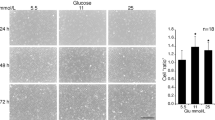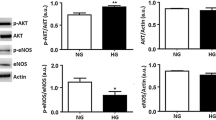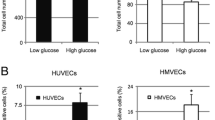Abstract
TNF-α and hyperglycemia are important factors contributing to vascular complications in obese and diabetic patients. The present studies aimed to examine, in endothelial cells, downstream signaling mechanisms that may ultimately link TNF-α and hyperglycemia to vascular pathology. Human umbilical vein endothelial cells were cultured and incubated with 10 ng/ml TNF-α and/or 25 mmol/l glucose. The expression of early growth response gene-1 (Egr-1) and ERK1/2 protein was quantified by Western blotting, and plasminogen activator inhibitor-1 (PAI-1) levels were measured by ELISA. Both glucose and TNF-α increased Egr-1 expression, while simultaneous exposure to the two factors exerted an additive effect. Furthermore, PAI-1 was also upregulated in the presence of TNF-α and glucose. The MEK inhibitor, PD98059, downregulated TNF-α-induced Egr-1 expression. TNF-α (10 ng/ml) increased ERK1/2 levels 1.76 ± 0.23-fold (P < 0.01) after 25 mmol/l glucose pretreatment, but added glucose did not enhance ERK1/2 activation when given subsequent to TNF-α treatment. TNF-α induced Egr-1 protein expression and PAI-1 levels through the ERK1/2 pathway. Differential regulation of Egr-1 expression by glucose and TNF-α in endothelial cells may be an important consideration in the mechanisms linking these factors to the development of vascular dysfunction in metabolic disorders such as diabetes.
Similar content being viewed by others
Avoid common mistakes on your manuscript.
Introduction
Obesity has become a global epidemic, carrying a considerable negative impact in regard to quality of life and life expectancy [1]. A major factor in this is that obese individuals are at increased risk for cardiovascular disease including myocardial infarction and stroke. As fat accumulation, including that located perivascularly, is a consistent finding in obesity, mechanisms linking adipose tissue to cardiovascular dysfunction should be considered.
Proteins expressed from adipose tissue, known as adipokines, have been hypothesized to have important effects on the incidence and progression of cardiovascular disease [2, 3]. Specifically, TNF-α has been proposed as a molecular link between obesity and insulin resistance [4]. Furthermore, TNF-α induces endothelial dysfunction in humans with an increased cardiovascular risk [5] and a compelling body of evidence is emerging to suggest that this adipocyte-derived cytokine plays a major role in atherosclerosis associated with obesity [6]. Importantly, in diabetes, both TNF-α and hyperglycemia appear as important factors leading to vascular complications.
Early growth response gene-1 (Egr-1) was originally identified as one of the immediate early genes associated with cell proliferation and differentiation [7]. Recent studies suggest that Egr-1 contributes to the pathogenesis of atherosclerotic lesions [8]. Thus, McCaffrey et al. [9] demonstrated sustained increases in Egr-1 expression, along with an increase in the expression of several Egr-1-regulated proteins in atherosclerotic lesions. This further suggests that Egr-1 may be involved not only in acute conditions of vascular injury but also in chronic conditions such as atherosclerosis. TNF-α induces the activation of extracellular signal-regulated kinases 1/2 (ERK1/2), a key transducer of extracellular signals that promote cell growth and movement, which are critical for the initiation and progression of vascular lesions [10]. Thus, in cultured RAW 264.7 mouse macrophages, TNF-α induced the expression of Egr-1 via activation of ERK1/2 [11].
PAI-1 is known to inhibit fibrin clot breakdown, thereby favoring thrombus formation upon ruptured atherosclerotic plaques [12]. In humans, circulating PAI-1 levels correlate with atherosclerotic events and mortality, and studies conclude that PAI-1 is an independent risk factor for coronary artery disease [13]. Our earlier study reported that TNF-α was associated with plasma PAI-1 levels and played a key role in obesity-related cardiovascular disease [14]. However, the exact mechanisms underlying this correlation have not been thoroughly investigated.
On the basis of the above, we have now examined the effects of TNF-α and hyperglycemia on the expression and activity of Egr-1, ERK1/2, and PAI-1 in human umbilical vein endothelial cells (HUVEC). The results suggest that TNF-α, but not glucose, induces Egr-1 protein expression and PAI-1 levels through the ERK1/2 pathway. Thus, a TNF-α-induced increase in Egr-1 expression in endothelial cells may represent an important factor in the development of cardiovascular disease in obesity.
Materials and methods
Cell culture
HUVECs (CRL 1730) were obtained from American Type Culture Collection (Manassas, VA). The cells were cultured in RPMI-1640 medium without glucose (Gibco, Logan, Utah, USA) supplemented with 10% heat-inactivated fetal calf serum (FCS), endothelial cell growth factor 3 mg/ml, penicillin 200U/ml, streptomycin 200 mg/ml, and l-glutamine 20 mmol/l, and incubated in a humidified atmosphere with 5%CO2 at 37°C. Cells were grown to 70–80% confluency and then starved for 24 h in RPMI-1640 without FCS. When cells reached confluence, they were treated with TNF-α (10 ng/ml) and glucose (25 mmol/l). HUVEC were added to a 96-well multiplate with 5 × 103cells in each well and incubated with RPMI-1640 medium without FCS to preserve quiescence. Twenty-four hours later, the medium was exchanged for RPMI-1640 medium supplemented with TNF-α and glucose.
Western blot analysis
For protein analysis, HUVECS were grown to 60–70% confluency and then starved for 24 h in RPMI-1640 without FCS. After various incubation periods with TNF-α (10 ng/ml) or glucose (25 mmol/l), cells were lysed and protein concentrations were determined using the Bradford dye-binding method with bovine serum albumin (BSA) as a standard. Proteins were separated by 12% SDS–PAGE, transferred to polyvinylidine fluoride membranes, and blocked with Tris-buffered saline with 5% Carnation nonfat milk (Nestle) in TBST. Membranes were incubated overnight with phospho-specific anti-ERK 1/2 (Santa Cruz Biotechnology) and anti-Egr-1 antibody (Santa Cruz Biotechnology). Membranes were washed in Tris-buffered saline with 0.02% Tween and incubated with appropriate secondary horseradish peroxidase-conjugated antibodies (BioRad). Immunoreactive proteins were visualized by enhanced chemiluminescence (ECL, Amersham) and quantified by densitometry using Molecular Analyst Software (Bio-Rad). The polyvinylidine fluoride membranes were immunoblotted with antibody for β-actin. Levels of phosphorylated ERK 1/2 and Egr-1 protein were normalized against β-actin, and the ratio of phosphorylated ERK 1/2 or Egr-1/β-actin was presented. All Western blot experiments were repeated at least three times with an independent cell preparation.
PAI-1 assay
Levels of PAI-1 in the cell supernatant were determined by specific enzyme-linked immunosorbent assay (ELISA) kits (Centaur). The assay procedure was carried out according to manufacturer’s instructions. Each supernatant sample and standard was measured in triplicate with PAI-1 concentration being determined against a standard curve. The minimum detectable dose of PAI-1 was 50 pg/ml. Intra-assay and inter-assay coefficients of variation were 5.5 and 8.3%, respectively.
Statistical analysis
All values are presented as mean ± SD. Analysis of variance was performed to compare for differences between the groups by using one-way analysis of variance (ANOVA) and Bonferroni test for post hoc comparisons. Significance was defined as P < 0.05. Analyses were performed using SPSS 11.5 for windows (SPSS, Chicago, IL).
Results
TNF-α and glucose additively increase Egr-1 protein expression
Serum-deprived cells were initially incubated with either TNF-α (10 ng/ml) or glucose (25 mmol/l). The effect of TNF-α and glucose on Egr-1 protein expression was then determined by Western blot analysis. Both TNF-α and glucose increased Egr-1 protein expression (by 1.92 ± 0.32-fold and 1.73 ± 0.16-fold at 60 min, respectively), but with differing time courses (Fig. 1). TNF-α-induced Egr-1 expression was transient, peaking at 60 min, whereas Egr-1 induced by glucose remained elevated until 240 min. When cells were incubated with both glucose and TNF-α, the Egr-1 expression level was increased 2.64 ± 0.28-fold and 2.34 ± 0.34-fold (P < 0.01) respectively, higher than that in cells incubated with either glucose or TNF-α alone. These data are consistent, therefore, with glucose and TNF-α having an additive effect on Egr-1 expression (Fig. 2).
Effects of glucose and TNF-α on egr-1 protein expression levels demonstrating differences in time courses. HUVEC were treated with 25 mmol/l glucose or 10 ng/ml TNF-α alone for 240 min. Egr-1 protein was measured by Western blotting method. The bands were quantified by densitometry, and the values were normalized to that of β-actin protein in the same sample. Similar results were obtained in three independent experiments
The additive effects of glucose and TNF-α on Egr-1 expression. HUVEC were treated with 25 mmol/l glucose or/and 10 ng/ml TNF-α for 240 min. Egr-1 protein was measured by Western blotting. The bands were quantified by densitometry, and the values were normalized to that of β-actin protein in the same sample. Each value represents the mean ± SD of the three independent experiments. ** P < 0.01 vs. untreated control; ## P < 0.01 vs. glucose and TNF-α group
Mechanisms involved in Egr-1 upregulation by TNF-α and glucose
We investigated whether extracellular signal-regulated kinase (ERK1/2) activation was involved in TNF-α or glucose-induced Egr-1 expression. Pretreatment of cells with the MEK inhibitor, PD98059 (20μmmol/l), for 30 min downregulated TNF-α-induced Egr-1 expression 63.08 ± 2.89% (P < 0.01), in contrast to no exchanges by glucose (Fig. 3).
The MEK inhibitor, PD98059, downregulated TNF-α-induced Egr-1 expression. Cells were pretreated with PD98059 (20μmmol/l) for 30 minutes and then exposed to either 25 mmol/l glucose or 10 ng/ml TNF-α for a further 60 min. Egr-1 protein was measured by Western blotting. The bands were quantified by densitometry, and the values were normalized to that of β-actin protein in the same sample. Each value represents the mean ± SD of the three independent experiments. **P < 0.01 vs. TNF-α and PD98059 group
Subsequently, we examined ERK1/2 protein expression in endothelial cells preincubated with TNF-α and/or glucose (Fig. 4). Both TNF-α and glucose induced ERK1/2 protein expression. In addition, we found that TNF-α (10 ng/ml) increased ERK1/2 levels 1.76 ± 0.23-fold (P < 0.01) after glucose (25 mmol/l) pretreatment for 1 h. In contrast, glucose did not enhance ERK1/2 activation after TNF-α pretreatment for 1 h. These results suggest that TNF-α, but not glucose, induces Egr-1 protein expression through ERK1/2 activation.
ERK1/2 protein expression in endothelial cells was measured by Western blotting. Both TNF-α and glucose increased ERK1/2 protein expression. In addition, 10 ng/ml TNF-α increased ERK1/2 levels after 25 mmol/l glucose pretreatment, while, in contrast, glucose did not enhance ERK1/2 activation after TNF-α pretreatment for 1 h. The bands were quantified by densitometry, and the values were normalized to that of β-actin protein in the same sample. Each value represents the mean ± SD of the three independent experiments. **P < 0.01 vs. glucose group. f glucose or TNF-α pretreated
TNF-α and glucose increase PAI-1 levels
To determine whether PAI-1 levels were upregulated, we examined PAI-1 levels released into the supernatants from cells pretreated with TNF-α (10 ng/ml) or glucose (25 mmol/l). Conceivably, glucose or TNF-α may increase the levels of PAI-1 in endothelial cells. When pretreated with PD98059, levels of PAI-1 decreased 30.43 ± 3.29% and 66.67 ± 2.99%, respectively (P < 0.01), in the glucose and TNF-α-exposed groups (Fig. 5).
Discussion
In the present study, we found that both glucose and TNF-α increased the expression of Egr-1 in HUVECs and, further, that the two factors exerted an additive effect. TNF-α induced Egr-1 and also PAI-1 expression via ERK1/2 activation. In contrast, high glucose alone did not cause activation of ERK1/2. It is conceivable that the differential regulation of Egr-1 expression by glucose and TNF-α in endothelial cells may be an important factor in the development of diabetic vascular complications.
The MEK inhibitor, PD98059, did not attenuate glucose-induced Egr-1 expression, and glucose did not increase TNF-α-related ERK1/2 activity, thus suggesting that the ERK1/2 pathway is not involved in glucose-induced Egr-1 expression. Rukhsana [15] reported that glucose-induced Egr-1 expression was mediated by PKC activation. Collectively, the available data suggest that TNF-α and glucose may regulate Egr-1 expression through different pathways, with glucose possibly mediating its effects through one of the PKC isoforms and TNF-α acting through the ERK1/2 pathway.
The possible importance of TNF-α and the ERK1/2 pathway in the pathogenesis of vascular alterations is receiving increased attention and is underscored by recent studies showing reduced vascular lesion formation in TNF-α-deficient mice receiving ERK1/2 antisense treatment [16]. ERK1/2 serves as a key signaling molecule for migration, proliferation, and other cellular responses that contribute to atherosclerotic changes within the arterial wall [17]. Inhibition of the ERK1/2 pathway, therefore, provides a logical pharmacological approach for protecting the vasculature from atherosclerotic damage. To date, however, selective and clinically accepted ERK1/2 inhibitors are not available.
PAI-1 is the primary inhibitor of plasminogen activation in vivo, and increased plasma PAI-1 compromises normal fibrin clearance mechanisms and promotes thrombosis [12]. PAI-1 has been shown to be elevated in several clinical studies of subjects with acute coronary syndromes [18–20]. Consistent with PAI-1 involvement, our data show that TNF-α may induce Egr-1 protein expression and PAI-1 levels through the ERK1/2 pathway.
Our studies are consistent with Egr-1 playing an important role in the cellular changes that underlie the development of cardiovascular complications, including atherosclerosis. TNF-α and glucose-induced expression of Egr-1 represents an early step in the development of diabetes-related cardiovascular complications. If such a direct link can be established, inhibition of this pathway may provide an approach for therapeutic intervention in the treatment of cardiovascular disease.
References
Beaudry M, Delisle H (2005) Public(‘s) nutrition. Public Health Nutr 8:743–748
Persson J, Lindberg K, Gustafsson TP, Eriksson P, Paulsson-Berne G, Lundman P (2010) Low plasma adiponectin concentration is associated with myocardial infarction in young individuals. J Intern Med 268:194–205. doi:10.1111/j.1365-2796.2010.02247.x
Chen C, Jiang J, Lü JM, Chai H, Wang X, Lin PH, Yao Q (2010) Resistin decreases expression of endothelial nitric oxide synthase through oxidative stress in human coronary artery endothelial cells. Am J Physiol Heart Circ Physiol 299:H193–H201. doi:10.1152/ajpheart.00431.2009
Nieto-Vazquez I, Fernández-Veledo S, Krämer DK, Vila-Bedmar R, Garcia-Guerra L, Lorenzo M (2008) Insulin resistance associated to obesity: the link TNF-alpha. Arch Physiol Biochem 114:183–194. doi:10.1080/13813450802181047
Martens FMAC, Rabelink TJ, op ‘t Roodt J, de Koning EJP, Visseren FLJ (2006) Tumor necrosis factor-alpha induces endothelial dysfunction in diabetic adults, an effect reversible by the PPAR-gamma agonist pioglitazone. Eur Heart J 27:1605–1609. doi:10.1093/eurheartj/ehl079
Paquot N, Tappy L (2005) Adipocytokines: link between obesity, type 2 diabetes and atherosclerosis. Rev Med Liege 60:369–373
Gururajan M, Simmons A, Dasu T, Spear BT, Calulot C, Robertson DA, Wiest DL, Monroe JG, Bondada S (2008) Early growth response genes regulate B cell development, proliferation, and immune response. J Immunol 181:4590–4602
Blessing E, Preusch M, Kranzhöfer R, Kinscherf R, Marx N, Rosenfeld ME, Isermann B, Weber CM, Kreuzer J, Gräfe J, Katus HA, Bea F (2008) Anti-atherosclerotic properties of telmisartan in advanced atherosclerotic lesions in apolipoprotein E deficient mice. Atherosclerosis 199:295–303. doi:10.1016/j.atherosclerosis.2007.10.037
McCaffrey TA, Fu C, Du B, Eksinar S, Kent KC, Bush H Jr, Kreiger K, Rosengart T, Cybulsky MI, Silverman ES, Collins T (2000) High-level expression of Egr-1 and Egr-1-inducible genes in mouse and human atherosclerosis. J Clin Invest 105:653–662. doi:10.1172/JCI8592
Demyanets S, Kaun C, Rychli K, Rega G, Pfaffenberger S, Afonyushkin T, Bochkov VN, Maurer G, Huber K, Wojta J (2007) The inflammatory cytokine oncostatin M induces PAI-1 in human vascular smooth muscle cells in vitro via PI 3-kinase and ERK1/2-dependent pathways. Am J Physiol Heart Circ Physiol 293:H1962–H1968. doi:10.1152/ajpheart.01366.2006
Shi L, Kishore R, McMullen MR, Nagy LE (2002) Lipopolysaccharide stimulation of ERK1/2 increases TNF-alpha production via Egr-1. Am J Physiol Cell Physiol 282:C1205–C1211. doi:10.1152/ajpcell.00511.2001
Sobel BE (1999) Increased plasminogen activator inhibitor-1 and vasculopathy. A reconcilable paradox. Circulation 99:2496–2498
Thogersen AM, Jansson JH, Boman K (1998) High plasminogen activator inhibitor and tissue plasminogen activator levels in plasma precede a first acute myocardial infarction in both men and women: evidence for the fibrinolytic system as an independent primary risk factor. Circulation 98:2241–2247
Cao YL, Wang YX, Wang DF, Meng X, Zhang J (2008) Correlation between omental TNF-alpha protein and plasma PAI-1 in obesity subjects. Int J Cardiol 128:399–405. doi:10.1016/j.ijcard.2007.05.033
Rukhsana N, Hasan Andrew I, Hemin Schafer (2008) Upregulates egr-1 expression in vascular smooth muscle cells via reactive oxygen species ERK-1/2–Elk-1 and NF-B. Circul Res 102:42–50. doi:10.1161/CIRCRESAHA.107.155143
Tuomilehto J, Lindstrom J, Eriksson JG (2001) Finnish diabetes prevention study group. Prevention of type 2 diabetes mellitus by changes in lifestyle among subjects with impaired glucose tolerance. N Engl J Med 344:1343–1350. doi:10.1056/NEJM200105033441801
Tchernof A, Nolan A, Sites CK (2002) Weight loss reduces C-reactive protein levels in obese postmenopausal women. Circulation 105:564–569
Sobel BE (1999) Increased plasminogen activator inhibitor-1 and vasculopathy. A reconcilable paradox. Circulation 99:2496–2498
Birgel M, Gottschling-Zeller H, Rohrig K, Hauner H (2000) Role of cytokines in the regulation of plasminogen activator inhibitor-1 expression and secretion in newly differentiated subcutaneous human adipocytes. Arterioscler Thromb Vasc Biol 20:1682–1687
Thogersen AM, Jansson JH, Boman K (1998) High plasminogen activator inhibitor and tissue plasminogen activator levels in plasma precede a first acute myocardial infarction in both men and women: evidence for the fibrinolytic system as an independent primary risk factor. Circulation 98:2241–2247
Acknowledgments
This project was supported by the National Natural Science Foundation of China (Grant No. 81000327/H0712).
Author information
Authors and Affiliations
Corresponding author
Rights and permissions
About this article
Cite this article
Cao, Y., Zhang, J., Meng, X. et al. TNF-α induces early growth response gene-1 expression via ERK1/2 activation in endothelial cells. Acta Diabetol 50, 27–31 (2013). https://doi.org/10.1007/s00592-010-0248-7
Received:
Accepted:
Published:
Issue Date:
DOI: https://doi.org/10.1007/s00592-010-0248-7









